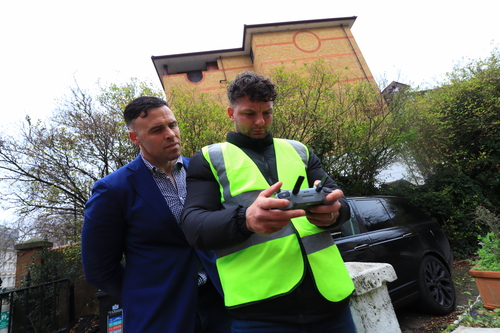- About Us
- Services
- Blog
- Contact
Need a quote?
Your roof is one of the most important parts of your home, protecting everything beneath it from rain, wind, and extreme temperatures. Yet, many London homeowners neglect regular roof inspections and roof maintenance, often because climbing onto a roof feels dangerous.
Fortunately, you don’t need to risk injury to keep tabs on your roof’s condition. With the right approach and tools, you can perform a thorough inspection safely and effectively.




Before thinking about ladders or roof access, start by walking around your property and observing your roof from the ground. Look for missing, cracked, or curling tiles, signs of sagging, or areas where moss or algae are accumulating.
Check for loose flashing around chimneys or vents, which can lead to leaks if left untreated. Using binoculars can help you see details clearly without leaving the safety of the ground.
If your roof is high or difficult to reach, consider using a drone roof survey or a telescopic inspection camera. These tools provide close-up images of your roof’s surface, helping you spot damage or wear without climbing up. In London, drone inspections are becoming increasingly popular because they are both safe and efficient, especially on larger properties.
Not all roof damage is visible from the outside. Inspect your attic or loft for signs of leaks, water stains, or damp patches. Look for mould growth, rotten wood, or insulation that has become wet or compressed. These interior checks can often reveal minor problems before they escalate into costly repairs.
It depends on the construction, but the minimum weight a flat roof must be capable of bearing is 300lbs. This refers to a concentrated weight where a load is positioned on just one area of the roof. So, for example, a commercial flat roof can approximately support a 300lb HVAC unit in a 2.5×2.5ft single space.
If you do need to get onto your roof, always prioritise safety. Use a sturdy ladder with a helper to hold it, wear non-slip shoes, and avoid walking on wet or icy surfaces. Consider using a safety harness if you are experienced and feel confident. For steep or complex roofs, it’s always safer to call a professional roofing company.

While regular inspections can prevent small issues from becoming big problems, some situations require professional attention. If you notice significant damage, persistent leaks, or structural issues, an experienced London roofer can safely assess the situation and recommend repairs or replacement.
Regular roof inspections don’t have to be dangerous. By combining ground-level observations, interior checks, and technology like drones, you can keep your roof in top condition without risking injury. Prioritising safety while staying vigilant ensures your home stays protected year-round.
And if you don’t want to get up there, just call a roofing company.

